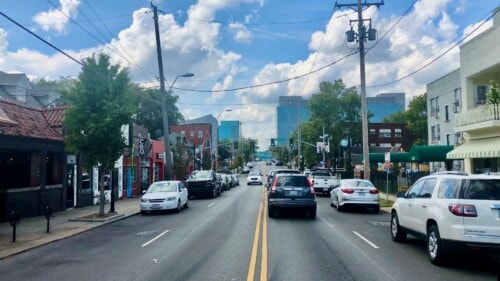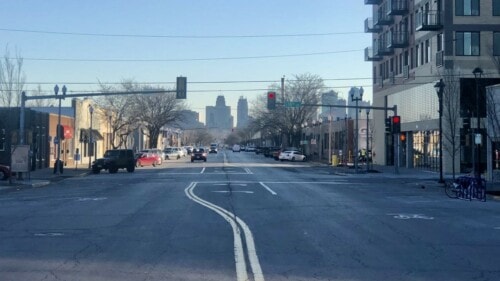- Home | News & Issues |
- East-West Streetcar Could Cost $600M, Need New Funding Source
East-West Streetcar Could Cost $600M, Need New Funding Source State Line to Van Brunt Route
Published February 10th, 2023 at 10:15 AM
Above image credit: The downtown streetcar line receives its local funding from a Transportation Development District. (Kevin Collison | CityScene)Kansas City has reached the end of the track when it comes to expanding its streetcar system unless it adopts a broader approach to local funding, according to a new study exploring a potential east-west route.
It would cost $450- to $600 million to build a streetcar line from the KU Medical Center to Van Brunt Boulevard and $6 million annually to operate, according to a report prepared for the Kansas City Area Transportation Authority.
The East-West Transit Study indicates that a transportation development district (TDD), the method that’s locally funding the streetcar line on Main Street, likely would not generate enough revenue to match potential federal funding.
The Main Street streetcar route gets its local funding from a property tax surcharge and additional sales tax imposed on businesses and properties within the TDD, a roughly one-third mile corridor on each side of the route.

The Main Street TDD includes the most densely developed and highly valued property in the city. A potential east-west corridor would generate far less sales and property tax surcharge revenues for a streetcar project.
Combined with a recent report that found a TDD also wouldn’t support an estimated $222 million extension into North Kansas City, it means streetcar expansion likely will end in 2025 when the Main Street extension is completed – unless new local funding is identified.
As to where that money might be found, the East-West Transit Study suggests potential new local transit funding could come from a city, county or a regional funding initiative. It also suggests that private funding could be potential source.
The new study did find a potential MAX Bus Rapid Transit line along the same east-west route would cost only a fraction of the cost to build, $30- to $60 million. However, it would not generate as much economic development or attract as many riders as a streetcar line.
The routes recommended in the report for both the streetcar and MAX would follow 39th Street from KU Med to either Broadway or Main where it would jog north and then follow either 31st Street or Linwood Boulevard to Van Brunt.

Officials at KU Med and the Unified Government of Wyandotte County previously have expressed support for studying a streetcar extension on 39th Street.
As for going as far east as the Truman Sports Complex, the study does not support the capital investment for either the streetcar or MAX stations beyond Van Brunt. It does indicate express bus service could be provided from there to the stadiums.
The study was presented this week at public meetings held at Habitat for Humanity on Linwood in Kansas City and Our Savior Lutheran Church in Kansas City, Kansas. It solicited comments on which mode of transportation and which route people preferred.
The East-West Transit Study has been underway for about a year and included online surveys and community meetings.
An initial survey obtained almost 2,000 responses.
On a scale of 1 to 5, respondents scored an average 3.75 when asked if enhancing east-west transit was important for themselves or their business, and 4.4 when asked how important better transit was to the economic and community vitality of the study corridor.
The study estimated it would take nine- to 10 years to line up the necessary federal funding, and design and build a potential streetcar east-west extension. A MAX extension would take about seven years to complete.
The recommended alternative is expected to be released next month.
Flatland contributor Kevin Collison is the founder of CityScene KC, an online source for downtown news and issues. Liam Dai contributed to this report.
More on Flatland
KC Streetcar Looks West to KU Med in Proposed New Study The Kansas City Streetcar Authority is considering a one-mile streetcar extension that would take passengers west on 39th Street from the new Main Street line and across the state line border to the KU Med Center.
North Kansas City Streetcar Extension Sidetracked by Financial Concerns A proposal to extend the streetcar to North Kansas City has hit a hard fiscal reality — it’s far too expensive to build utilizing the local funding methods that have developed the system so far.
Tags: CityScene • development • Kansas City Area Transportation Authority • KC Streetcar • public transit
Like what you are reading?
Discover more unheard stories about Kansas City, every Thursday.
Thank you for subscribing!
Check your inbox, you should see something from us.
Ready to read next




